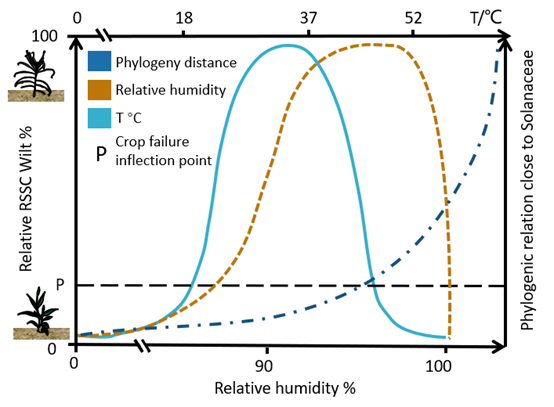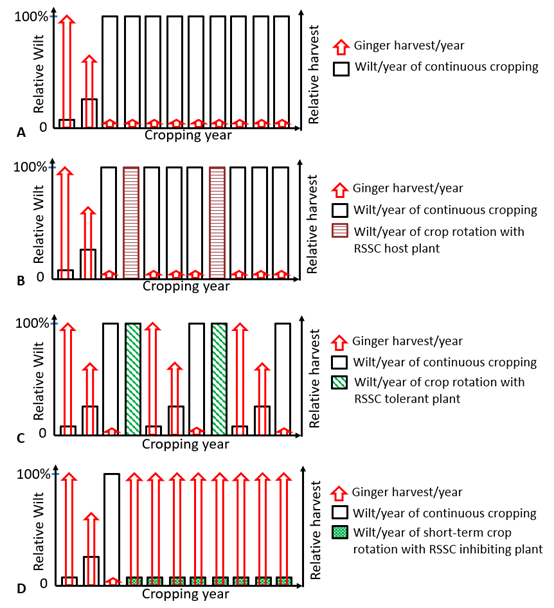eISSN: 2576-4462


Research Article Volume 6 Issue 3
1Institute of Horticultural Biotechnology, Fujian Agriculture and Forestry University, Fuzhou 350002, China
2Dehua Ginger Industry Research Institute, Quanzhou, 353111, China
3Jianou PhytoRTD Eco-Agriculture Co. Ltd., Jianou, 353111, China
4Institut de la Recherche Interdisciplinaire de Toulouse, Toulouse, 31300, France
Correspondence: Xu XuHan, Institute of Horticultural Biotechnology, Fujian Agriculture and Forestry University, Fuzhou, China;Dehua Ginger Industry Research Institute, Quanzhou, 353111, China; Jianou PhytoRTD Eco-Agriculture Co. Ltd., Jianou, 353111, China; Institut de la Recherche Interdisciplinaire de Toulouse, Toulouse, 31300, France
Received: May 17, 2022 | Published: July 13, 2022
Citation: Gan Y, Ban J, Guo R, et al. Ralstonia solanacearum: a potential target by organic ecology in ginger (Zingiber officinale Roscoe) production. Horticult Int J. 2022;6(3):115-118. DOI: 10.15406/hij.2022.06.00252
Extensive cultivation of ginger for years caused ecological environment worse off and ginger productivity decrease due to wilt diseases, which also happens in nearly all crops in continuous cropping, especially in Ralstonia solanacearum caused wilt farmlands. In the present work, based on analysis of Ralstonia solanacearum species complex (RSSC) host plant phylogeny and RSSC control factors, an organic ecological method to combat the wilt is proposed that is expected to guarantee continuous cropping of ginger (Zingiber officinale Rosc.) achieving double harvest in economy and environment.
Keywords: Zingiber officinale, Ralstonia wilt, RSSC, continuous cropping, rotation cropping, organic ecology
Ralstonia solanacearum is a soil-borne pathogen widely distributed in tropical, subtropical and some warm temperate regions of the world.1 Due to its wide geographical distribution and host range, it causes the most harmful and widely distributed disease in the world.
R. solanacearum infects phylogenic distant plants through wounds, root tips or cracks at the site of lateral root initiation. The pathogenic bacteria colonize the root cortex, invade the xylem vessels, and reach the stem and aerial parts of the plant through the vascular system. It can multiply rapidly in the xylem, reaching very high cell densities, causing symptoms of wilting and even death.2
R. solanacearum pathogen belongs to Bacteria, Proteobacteria, Betaproteobacteria, Burkholderiales, Burkholderiaceae, Ralstonia, R. solanacearum (Tax Browser, NCBI, http://www.ncbi.nlm.nih.gov/). Since its increasing diverse members in the group, it is referred as Ralstonia solanacearum species complex (RSSC).3-5 In historic literature, the first RSSC member was found and named Bacillus solanacearum, and more members of RSSC were observed and named by some authors in different taxonomic positions, such as Bacterium, Pseudomonas, Phytomonas solanacearum, Xanthomonas solanacearum.5
RSSC species consist of a large group of strains that vary in geographic origin, host range, and pathogenic behavior. This heterogeneous group, i.e., RSSC, is divided into 4 phylotypes based on phylogenetic analysis of DNA sequence variations, and more or less parallel 5 physiological races according to its phenotypic characteristics, which can be briefly summarized as following (phylotype, origin, biovar/race):
The first physiological strain (race 1) can infect a variety of solanaceous plants, weeds and diploid bananas. It is called solanaceous strain.The second physiological strain (race 2) mainly causes the wilt disease of triploid banana and Heliconia (moko disease), also known as musaceous strain. The third physiological strain (race 3) mainly harms potatoes and tomatoes, but is less pathogenic to other solanaceous plants, and is called potato strain. The fourth physiological strain (race 4) is isolated from wilt ginger plants and only infects ginger, named ginger strain. The fifth physiological strain (race 5) is isolated from mulberry trees, and is harmful to mulberry trees whereas weak pathogenic to potatoes and eggplants, known as mulberry strain.6
As all the RSSC members invade host plants via the type III effectors (T3Es) and type III secretion system (T3SS) parasitizing machinery, a cause of extremely broad host range throughout the world, including more than 450 plants of more than 50 families.7,8 Analyses of virulence factors (VFs) and horizontal gene transfer (HGT) in the pangenome and at the single genome level shows diverse evolutionary and pathogenetic events in RSSC. The distribution of VFs and mobile genetic elements (MGEs) shows significant differences among different groups and strains, which is consistent with the new nomenclatures of the RSSC, and HGT events may contribute more in shaping the genomic plasticity and genetic diversity of RSSC genomes,9 thus enhance the host capacity.
According to the newest version of angiosperm taxonomy system, i.e., Angiosperm Phylogeny Group IV,10 RSSC hosts distribute extensively in angiosperm taxa (Figure 1). In Zingiberales, RSSC race 4 members host Zingiberaceae (ginger), and race 2 in Musaceae. However, the data in phylogenic figure (Figure 1) do not mean that a member of RSSC is able to invade a plant species but definitely unable to invade the plant species’ phylogenetically closed plant taxa. It may only because the two plants are not growing or cultivated in the same place or ecological site.
Ginger (Zingiber officinale Roscoe) is a perennial monocotyledonous perennial herb of Zingiberaceae family (Zingiberales Order in Figure 1), which is cultivated as an annual crop in China in more than 2000 years.11
The RSSC wilt is reportedly only caused by RSSC race 4 in ginger up to date. After ginger is infected with the RSSC, the bacterial wilt usually occurs from June to September, especially when high temperature and high humidity are encountered, leading to production losses or even total crop failure.12 Various biotic, abiotic, ecological factors and cultivation operations affect the wilt development, e.g., climate, temperature, soil moisture, soil acidification, heavy metal content, cropping, nearby crops cultivated, pests and other diseases. For example, temperature range for the growth of RSSC race 4 is 18-37°C, the optimum is 30-35°C, and lethal temperature is 52°C for 10 minutes (Figure 2). The RSSC race 4 living range of pH is 4-8 and the optimum is 6.6. The pathogen can survive for 2-3years or even longer in plant body, and it survives in soil for 7 months or years except for in dry conditions or disinfection. When the wilt happens, it may take only a week to spread over the fields and non-chemical control methods may contribute very limited to rescue ginger plants in the farmland.12-15

Figure 2 A diagram representation of RSSC wilt disease plotting ecological factors in ginger crop based on historic literature. The point P represents the maximum threshold of RSSC wilt disease in relation to meaningful ginger harvest.
Whenever RSSC wilt spreads, three basic factors are always encountered and play important roles in the wilt development, i.e., humidity, temperature and crop plant species (Figure 2). The three factors are in the scope of decision-making both in the estimation of RSSC wilt development and in pathogen control.
Many molecular, cellular, physiologic, genetic, chemical and environmental methods have been developed to combat the pathogen, e.g., wilt disease-tolerant line breeding, soil disinfection, crop rotation, fertilization, watering, and fine management such as timely eradication of diseased plants.12,16,17 Input, however, is always heavy.
In agriculture, large scale wilt damaged ecological environment cannot be restored to the original form by either farming or environmental operations. Organic ecology methods need to be applied according to ecological principles to reconstruct ecology and at the same time to balance with social needs.18 Thus, an optimized cropping system should be developed aiming at the lowest input as well as the highest benefits in both ginger economy and eco-environment. Compared with RSSC wilt control methods ever used, rotation cropping is the easiest method with lowest input and without any secondary contamination or pollution, for which the only drawback is the year of rotation give rise to zero income from ginger (Figure 3). The question thus points to the possibility of a short-term rotation, performed between the culture seasons of ginger. An RSSC inhibiting plant species may provide such a farming system so that in an inter-farming season of ginger, such as in the winter between two ginger cultivation seasons, the RSSC inhibiting plant species can effectively function as a year rotation with conventional crops, enabling ginger farmers to have continuous ginger cropping benefits, and even to get added value if the species is a commercial valuable crop. A design and comparison of the rotation systems is shown in the diagram (Figure 3).

Figure 3 A diagram representation of RSSC wilt disease in ginger continuous cropping (A) compared with insertion of rotation faming with RSSC host (B), RSSC tolerant (C) and RSSC inhibiting plants (D).The rotation (D) provides a possibility to insert a rotational faming of an RSSC inhibiting crop between ginger faming seasons such as in the winter to realize healthy continuous ginger cropping.
Based on the model of rotation cropping (Figure 3), an optimized cropping system is to minimize rotation cropping time-length with an RSSC- inhibiting plant. it is foreseeable that the selected plant species should meet the following conditions: (1) it is ideally able to grow in winter vigorously; (2) it is phylogenetically distant from plants that can be infected by any RSSC members; (3) its root system can produce certain metabolites that inhibit RSSC pathogens;19 (4) it is commercially valuable if available. According to these categories, extensive and intensive laboratory research bench work and field trails have been doing in Daming area, Quanzhou, China. Our primary analysis shows that RSSC pathogens in heavy wilt fields are largely inhibited after 3-month winter cultivation with certain RSSC-inhibiting crop species. Thus, an inter-rotation cropping based organic ecological method enabling ginger continuous cropping to gain the best ginger commercial and ecological benefits is promising.
Yu Gan and Jingjie Ban drafted the manuscript and analyzed literature. Xu XuHan, Rongfang Guo, Yuling Lin and Zhongxiong Lai designed the research and revised the paper. All authors have read and approved the final version.
Liangchun Xu, Binghuang Hong and Shian Lai provided Dehua field data and literature information.
This work was funded by the Plateau Discipline Construction Fund Project of Fujian Province (No.102/71201801101), Minjiang Scholars Award Program of Fujiang Province (No. MJJZ13-003), Identification of the germplasm resources and rapid breeding of high-quality seedlings of Polygonatum cyrtonema in Fujian Province (No.102/KH200373A). Project of Special Horticultural Crop Biotechnology and Industrialization Service Team.

©2022 Gan, et al. This is an open access article distributed under the terms of the, which permits unrestricted use, distribution, and build upon your work non-commercially.